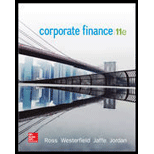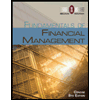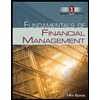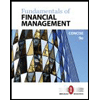
Concept explainers
a.
To identify: The company would be able or not to boost the profit, if it changes the cash management policy.
Cash management:
Cash management refers to that arrangement in which the company manages the cash inflows and
a.
Explanation of Solution
Statement to show the surplus or deficit
| Particulars |
Quarter 1 (million $) |
Quarter 2 (million $) |
Quarter 3 (million $) |
Quarter 4 (million $) |
| Beginning cash balance | 20 | 20 | 20 | 20 |
| Net |
5.80 | (24.64) | 3.64 | 25.40 |
| Less: New short-term investments | 6.14 | 22.53 | ||
| Income on short-term investment | 0.24 | 0.36 | ||
| Short-term investments sold | 18.04 | |||
| New short-term borrowings | 6.24 | |||
| Less: Interest on short-term borrowings | 0.19 | 0.08 | ||
| Short-term borrowing repaid | 3.45 | 0.279 | ||
| Ending cash balance | 19.90 | 20 | 20 | 22.51 |
| Minimum cash balance | 20 | 20 | 20 | 20 |
| Cumulative Surplus/deficit | (0.10) | 2.51 | ||
| Beginning short-term investments | 12 | 18.04 | ||
| Ending short-term investments | 18.04 | 22.53 | ||
| Beginning short-term debt | 0 | 0 | 6.24 | 2.79 |
| Ending short-term debt | 0 | 6.24 | 2.79 | 0 |
Table (1)
Compute the net cash cost
The interest income in Quarter 1 is $0.24.
The interest income in Quarter 2 is $0.36.
The interest expense in Quarter 3 is $0.19.
The interest expense in Quarter 4 is $0.08.
Formula to compute the net cash cost:
Substitute $0.24 for interest earned in Quarter 1, $0.36 for interest earned in Quarter 2, $0.19 for interest expense in Quarter 3 and $0.08 for interest expense in Quarter 4,
Working Note:
Statement to show the computation of net cash inflows:
| Particular |
Quarter 1 (million $) |
Quarter 2 (million $) |
Quarter 3 (million $) |
Quarter 4 (million $) |
| Beginning receivables | 34 | 52.50 | 45 | 61 |
| Add: Sales | 105 | 90 | 122 | 140 |
| Less: Collection of accounts | 86.5 | 97.50 | 106 | 131 |
| Ending receivables | 52.5 | 45 | 61 | 70 |
| Payment of accounts | 43.20 | 49.14 | 59.76 | 57.6 |
| Add: Wages, taxes, and expenses | 31.5 | 27 | 36.6 | 42 |
| Add: Capital expenditures | 40 | |||
| Add: Interest and dividends | 6 | 6 | 6 | 6 |
| Total cash disbursements | 80.70 | 122.14 | 102.36 | 105.60 |
| Total cash collections | 86.50 | 97.50 | 106 | 131 |
| Total ash disbursements | 80.70 | 122.14 | 102.36 | 105.60 |
| Net cash inflow | 5.80 | (24.64) | 3.64 | 25.40 |
Table (2)
Compute the interest income in Quarter 1:
Compute the interest income in Quarter 2:
Compute the interest expenditure in Quarter 3:
Compute the interest expenditure in Quarter 4:
Hence, the net cash cost is $0.33.
b.
To identify: The company would be able or not to boost the profit, if it changes the cash management policy.
b.
Explanation of Solution
Statement to show the surplus or deficit:
| Particulars |
Quarter 1 (million $) |
Quarter 2 (million $) |
Quarter 3 (million $) |
Quarter 4 (million $) |
| Beginning cash balance | 10 | 20 | 20 | 20 |
| Net cash inflow | 5.80 | (24.64) | 3.64 | 25.40 |
| Less: New short-term investments | 6.24 | 3.72 | 25.56 | |
| Income on short-term investment | 0.44 | 0.56 | 0.08 | 0.16 |
| Short-term investments sold | 24.08 | |||
| New short-term borrowings | ||||
| Less: Interest on short-term borrowings | ||||
| Short-term borrowing repaid | ||||
| Ending cash balance | 19.90 | 20 | 22.51 | |
| Less: Minimum cash balance | 10 | 10 | 10 | 10 |
| Cumulative Surplus/deficit | ||||
| Beginning short-term investments | 22 | 28.247 | 4.16 | 7.89 |
| Ending short-term investments | 28.24 | 4.16 | 7.89 | 33.6 |
| Beginning short-term debt | 0 | 0 | 0 | 0 |
| Ending short-term debt | 0 | 0 | 0 | 0 |
Table (3)
Compute the net cash cost
The interest income in Quarter 1 is $0.44.
The interest income in Quarter 2 is $0.56.
The interest income in Quarter 3 is $0.08.
The interest income in Quarter 4 is $0.16.
Formula to compute the net cash cost:
Substitute $0.44 for interest earned in Quarter 1, $0.56 for interest earned in Quarter 2, $0.08 for interest expense in Quarter 3 and $0.16 for interest expense in Quarter 4,
Working Note:
Compute the interest income in Quarter 1:
Compute the interest income in Quarter 2:
Compute the interest income in Quarter 3:
Compute the interest income in Quarter 4:
No, the company should not change the cash management policy as these policies give the more net cash cost and the company can consider any other factors but it is not necessary for it.
Company should not change its cash management policy as its net cash cost increases.
Want to see more full solutions like this?
Chapter 26 Solutions
Corporate Finance (The Mcgraw-hill/Irwin Series in Finance, Insurance, and Real Estate)
- Risk associated with a particular firm’s operating conditions is which of the following risk? a.Financial Risk b.Business Risk c.Liquidity Risk d.Interest Riskarrow_forwardThe discounted cash flow is which of the following approach? a.Forward approach b.Risk approach c.Earnings approach d.Backward approacharrow_forwardexplain The risk that arises due to use of debt by the firm causing variability of return for creditors and shareholders is: a.Liquidity Risk b.Call Risk c.Default Risk d.Financial Riskarrow_forward
- 53. A fixed cash flow in each year for a specified number of years is called as……. a.Annuity b.Compounding c.Reovery Factor d.Discountingarrow_forwardWhat is the full form of "NYSE"? a.Net uield Security Exchnage b.National Stock Exchange c.Net Asset Value d.New York Stock Exchnagearrow_forwardThe method of converting the amount of future cash into an amount of cash and cash equivalents value in present is known as: a.Annuity b.Compounding c.None of these d.Discountingarrow_forward
- The risk that arises due to use of debt by the firm causing variability of return for creditors and shareholders is: a.Liquidity Risk b.Call Risk c.Default Risk d.Financial Riskarrow_forward47. The value of holding period return is always show: a.Greater than 0 b.Less than 0 c.Negative d.Equal to 0arrow_forwardCurrent yield is equal to What? a.Market yield b.Any of these c.Income yield d.Running Yieldarrow_forward
- Explain. The financial activities which are performed regularly are known as: a.Recurring Finance b.None of these c.Non-recurring finance functions d.Both a and barrow_forwardThe risk in terms of variability in security’s total return due to some exogenous factors is known as: a.systematic risk b.Unsystematic risk c.None of these d.Non diversifiable riskarrow_forwardThe Wildcat Oil Company is trying to decide whether to lease or buy a new computer-assisted drilling system for its oil exploration business. Management has decided that it must use the system to stay competitive; it will provide $3 million in annual pretax cost savings. The system costs $8.9 million and will be depreciated straight-line to zero over five years. Wildcat's tax rate is 21 percent, and the firm can borrow at 7 percent. Lambert Leasing Company is willing to lease the equipment to Wildcat. Lambert's policy is to require its lessees to make payments at the start of the year. Suppose it is estimated that the equipment will I have an aftertax residual value of $900,000 at the end of the lease. What is the maximum lease payment acceptable to Wildcat? Note: Do not round intermediate calculations and enter your answer in dollars, not millions of dollars, rounded to 2 decimal places, e.g., 1,234,567.89. Maximum lease paymentarrow_forward
 Intermediate Financial Management (MindTap Course...FinanceISBN:9781337395083Author:Eugene F. Brigham, Phillip R. DavesPublisher:Cengage Learning
Intermediate Financial Management (MindTap Course...FinanceISBN:9781337395083Author:Eugene F. Brigham, Phillip R. DavesPublisher:Cengage Learning Fundamentals of Financial Management, Concise Edi...FinanceISBN:9781285065137Author:Eugene F. Brigham, Joel F. HoustonPublisher:Cengage Learning
Fundamentals of Financial Management, Concise Edi...FinanceISBN:9781285065137Author:Eugene F. Brigham, Joel F. HoustonPublisher:Cengage Learning Excel Applications for Accounting PrinciplesAccountingISBN:9781111581565Author:Gaylord N. SmithPublisher:Cengage Learning
Excel Applications for Accounting PrinciplesAccountingISBN:9781111581565Author:Gaylord N. SmithPublisher:Cengage Learning Fundamentals of Financial Management (MindTap Cou...FinanceISBN:9781285867977Author:Eugene F. Brigham, Joel F. HoustonPublisher:Cengage Learning
Fundamentals of Financial Management (MindTap Cou...FinanceISBN:9781285867977Author:Eugene F. Brigham, Joel F. HoustonPublisher:Cengage Learning Fundamentals of Financial Management, Concise Edi...FinanceISBN:9781305635937Author:Eugene F. Brigham, Joel F. HoustonPublisher:Cengage Learning
Fundamentals of Financial Management, Concise Edi...FinanceISBN:9781305635937Author:Eugene F. Brigham, Joel F. HoustonPublisher:Cengage Learning





